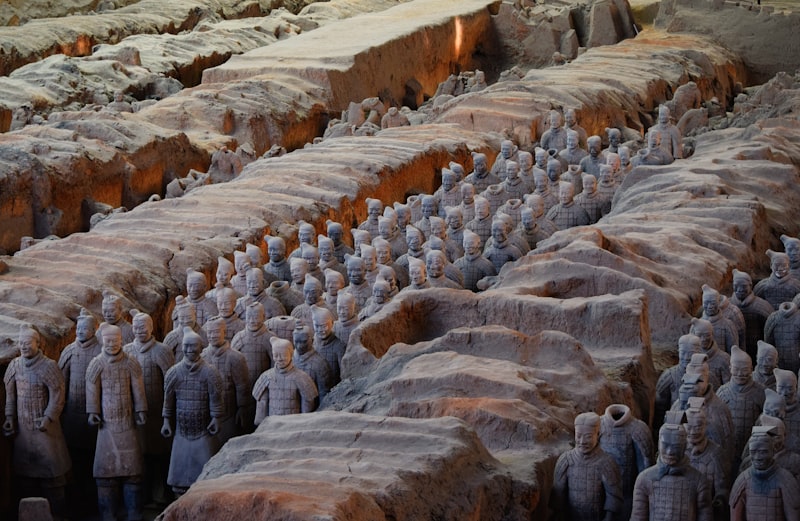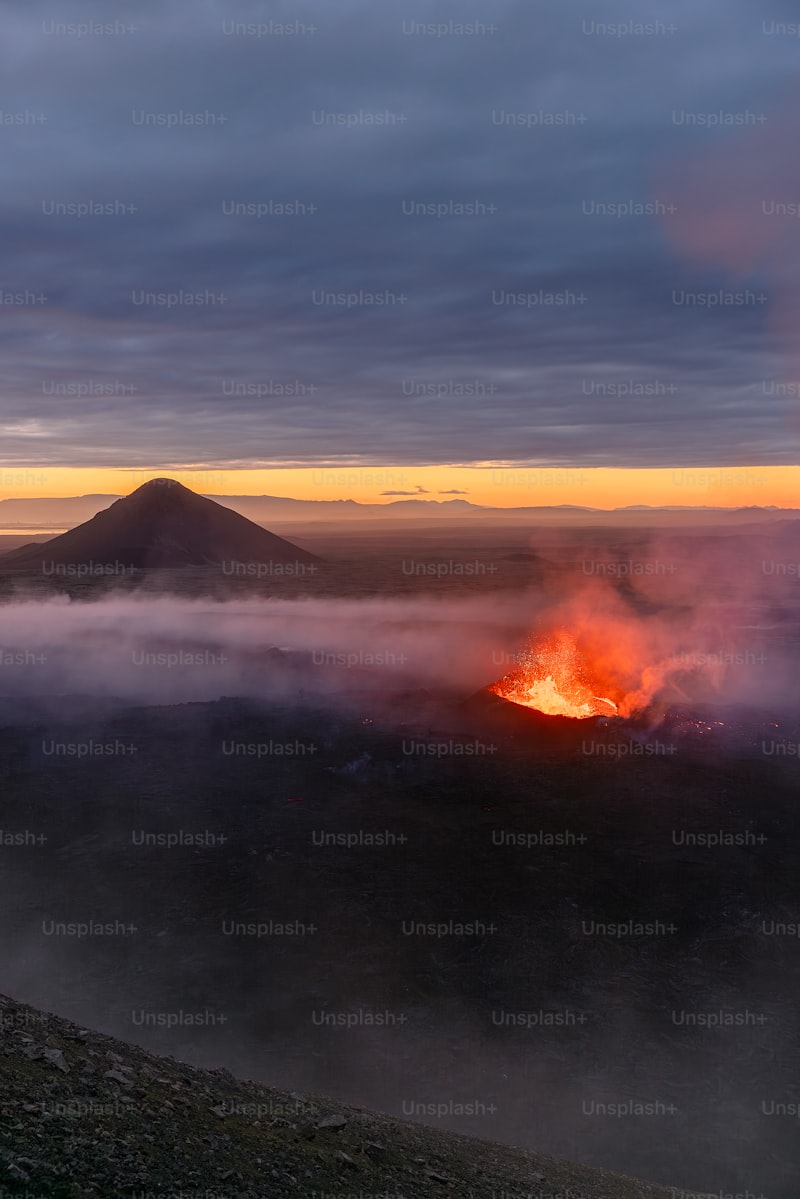Ancient volcanoes, relics of Earth’s turbulent past, offer a glimpse into geological history. These towering giants, now dormant, once roared with fiery vigor, sculpting the terrain with each eruption. Today, they stand as silent sentinels, their rugged outlines contrasting sharply against the horizon.
One of the most captivating aspects of ancient volcanoes is their sheer size and scale. Take, for instance, Mount Vesuvius in Italy, infamous for its eruption in AD 79 that buried the cities of Pompeii and Herculaneum. Standing at its base, one can’t help but marvel at the enormity of this natural wonder, a testament to the Earth’s power.
But it’s not just their size that fascinates; it’s also their geological significance. Ancient volcanoes provide scientists with valuable insights into the Earth’s composition and evolution. By studying their rock formations and lava flows, researchers can piece together the puzzle of our planet’s history, unraveling mysteries that have been buried for millions of years.
Moreover, these volcanic landscapes are often rich in biodiversity, showcasing nature’s resilience. Despite the harsh conditions, life finds a way to thrive in the shadow of these giants. Unique plant species cling to rocky crevices, while animals carve out niches in the rugged terrain. It’s a testament to the adaptability of life and the interconnectedness of ecosystems.
Visiting these ancient volcanoes is like stepping back in time, where the air is thick with a sense of awe and wonder. Standing atop a dormant crater, surrounded by panoramic views of rugged terrain, one can’t help but feel a profound connection to the Earth and its storied past. It’s a humbling experience, reminding us of our place in the grand tapestry of the natural world.
Exploring Earth’s History: The Stunning Landscapes Carved by Ancient Volcanoes
The landscapes we admire today, shaped by ancient volcanoes, tell tales of fire and fury that once dominated these lands. From the towering peaks of dormant volcanoes to the sweeping valleys carved by lava flows, each vista holds a piece of Earth’s history. These geological wonders aren’t just static remnants; they are dynamic stages where nature continues to unfold its drama.
One such marvel is the volcanic archipelago of Hawaii, where the earth breathes through the vents of Kīlauea and Mauna Loa. Here, rivers of molten rock once surged across the land, cooling into the dramatic black sands of Punalu’u Beach. As the lava met the ocean, it sculpted sea cliffs and formed new shores, forever altering the island’s coastline.
Travel across the globe to Iceland, where the ground steams with geothermal energy beneath the watchful eye of Eyjafjallajökull. This land of ice and fire boasts a landscape dotted with volcanic craters and moss-covered lava fields. Each eruption adds a new layer to Iceland’s story, as fiery magma meets icy glaciers, shaping fjords and valleys over millennia.
Closer to home, the Pacific Northwest of the United States bears the scars of ancient volcanic activity in the form of Mount St. Helens. Once a towering peak, its eruption in 1980 left behind a moonscape of ash and pumice, slowly giving way to the return of life in the blast zone. Today, visitors witness the regrowth of lush forests amidst the stark reminder of nature’s raw power.
From the towering peaks of the Andes to the sunken calderas of the Mediterranean, Earth’s history is etched in the landscapes forged by ancient volcanoes. Each vista invites us to ponder the forces that shaped our planet and continues to shape its future. As we explore these stunning landscapes, we are reminded that beneath our feet lies a story written in fire and preserved in stone, waiting to be discovered anew with every journey into the heart of our volcanic Earth.
Journey Through Time: Discovering the Geological Wonders of Ancient Volcanoes
Imagine standing on the edge of a crater that once roared with molten fury millions of years ago. These ancient volcanoes, dormant for ages, hold within them a story of Earth’s tumultuous past. From the towering peaks of Mount Vesuvius in Italy to the remote volcanic islands of Hawaii, each holds a unique tale of creation and destruction.
Volcanoes are not merely mountains; they are windows into Earth’s inner workings. Beneath their surface, magma from deep within the Earth rises, shaping the land around them with each eruption. The layers of hardened lava and volcanic ash preserve a timeline of geological events, offering scientists a glimpse into the planet’s evolution.
One of the most striking features of ancient volcanoes is their ability to create entire landscapes. The volcanic soil, rich in minerals and nutrients, supports lush vegetation that thrives in the wake of destruction. From the fertile slopes of Mount Etna in Sicily to the volcanic fields of Iceland, life flourishes amidst the remnants of past eruptions.
But volcanoes are not just about destruction; they also create breathtaking formations that defy imagination. Picture the dramatic cliffs of Santorini, Greece, where volcanic eruptions shaped the iconic caldera that now attracts tourists from around the world. Or the otherworldly lava tubes of Lanzarote in the Canary Islands, where underground passages reveal the raw power of volcanic activity.
Secrets of the Earth Unveiled: How Ancient Volcanoes Shape Today’s Landscapes
Have you ever wondered about the hidden forces that sculpt our planet’s majestic landscapes? Ancient volcanoes, once roaring with molten fury, hold the key to understanding the dramatic scenery we see today. These geological giants, dormant for millennia, continue to influence our environment in profound ways.
Imagine the Earth as an artist’s canvas, where each volcanic eruption paints a unique masterpiece. From towering mountains to fertile valleys, the legacy of volcanic activity is etched into the very fabric of our world. But how exactly do these ancient behemoths shape today’s landscapes?

Volcanic eruptions, like nature’s explosive symphonies, leave behind a legacy of rugged terrain and fertile soil. The lava flows from these eruptions cool and solidify over time, forming basaltic plains or rugged cliffs that stand as testaments to the Earth’s fiery past. These formations provide habitats for unique ecosystems and stunning vistas that attract adventurers and scientists alike.
Moreover, volcanic soils are exceptionally rich in nutrients, making them ideal for agriculture and fostering diverse plant life. Regions like the volcanic islands of Hawaii or the fertile slopes of Mount Etna in Sicily owe their lush vegetation to these nutrient-rich soils.
But the impact of ancient volcanoes extends beyond mere aesthetics and agriculture. They play a crucial role in shaping our climate and even influencing local weather patterns. The release of gases and ash during volcanic eruptions can temporarily cool the Earth’s atmosphere, affecting global temperatures and weather systems.
In essence, the secrets of the Earth are unveiled through the enduring legacy of ancient volcanoes. Their story is not just one of destruction but also of creation and renewal, shaping our world in ways both subtle and profound. As we marvel at the landscapes around us, let us remember the fiery origins that continue to shape our planet today.
Beyond the Horizon: Photographing the Majestic Scenery of Ancient Volcanoes
One of the most captivating aspects of photographing ancient volcanoes is their sheer grandeur. These dormant giants, once spewing molten rock and ash, now stand silently, their slopes cloaked in lush greenery or rugged barrenness. Each crater tells a story of tumultuous eruptions that shaped the land and left behind a legacy of geological wonders.
The play of light and shadow on these ancient slopes creates a photographer’s dream. During sunrise, the soft hues of dawn bathe the peaks in a golden glow, while sunset paints the sky with fiery oranges and purples, casting long shadows over the rugged terrain. Capturing these moments requires not just a keen eye but also patience, waiting for the perfect interplay of nature’s elements.
Moreover, ancient volcanoes are often surrounded by unique ecosystems that add to their allure. From the mist-covered forests of Hawaii’s Mauna Kea to the stark lunar landscapes of Mount Etna in Sicily, each volcano offers photographers a chance to explore a diverse range of environments within a single location. This diversity allows for a rich tapestry of images, from close-up shots of rare flora to wide-angle panoramas of sweeping vistas.
Photographing ancient volcanoes also offers a glimpse into Earth’s history. These geological giants have witnessed millennia of change, from the rise and fall of civilizations to the shifting of continents. Each photograph captured serves as a window into the past, preserving moments frozen in time for future generations to marvel at and study.
Nature’s Canvas: Capturing the Colors and Textures of Ancient Volcanic Formations
Imagine standing at the edge of a vast landscape, where the earth tells a story of ancient upheavals and fiery eruptions. These are not just rocks and cliffs; they are Nature’s own canvases, painted over millennia with hues and textures that mesmerize and captivate.
Ancient volcanic formations are more than just geological features; they are artworks crafted by the Earth itself. From the rugged basalt columns of the Giant’s Causeway to the surreal hexagonal prisms of Fingal’s Cave, each formation holds a unique tale of molten lava meeting the cool embrace of air or water.
One of the most striking aspects of these formations is their color palette. Picture the vivid contrast of dark basalt against the vibrant greens of surrounding foliage, or the ochre tones that hint at the minerals embedded within. These colors are not merely shades on a canvas but clues to the volcanic processes that shaped them.
Textures add another layer of intrigue. Run your fingers over the rough surface of a lava flow frozen in time, or marvel at the smooth curves of volcanic glass formed from rapid cooling. These textures are a testament to the dynamic forces that once roared beneath the Earth’s surface.

But why are these formations so captivating? Perhaps it’s because they offer a glimpse into Earth’s tumultuous past, where molten rock sculpted the land we now tread. Or maybe it’s the sheer scale and grandeur that awakens a sense of wonder and humility in us.
Standing amidst these ancient volcanic formations, one can’t help but wonder about the processes that shaped them. How did magma solidify into such intricate patterns? What forces lifted these formations high above the ground? These questions invite us to delve deeper into Earth’s geological history, where every layer of rock holds a clue.

In essence, exploring ancient volcanic formations is like stepping into a natural art gallery where every turn reveals a masterpiece. It’s a reminder that Nature is not only a creator but also a storyteller, weaving tales of fire and ice, chaos and creation, in the very fabric of the Earth.
Nature’s canvas is vast and ever-changing, inviting us to look closer, to appreciate the colors and textures that paint the landscape. Each formation, whether towering cliffs or delicate mineral deposits, adds a stroke to this masterpiece that continues to evolve with time.
Thrilling Adventures: Hiking Trails and Activities Around Ancient Volcanic Sites
Imagine stepping onto a trail where every step echoes the footsteps of ancient civilizations, where lava once flowed and shaped the landscape into rugged beauty. These hikes aren’t just about walking; they’re about uncovering the secrets of our planet’s past.
One such trail takes you through the remnants of a volcanic eruption that occurred centuries ago. As you ascend, the landscape transforms, revealing panoramic vistas that stretch as far as the eye can see. The air crackles with a sense of history, urging you to delve deeper into the story written in the rocks beneath your feet.
The thrill intensifies as you stumble upon ancient petroglyphs etched into the rocks, offering a glimpse into the lives of those who once called this fiery terrain home. Each carving tells a tale of survival and adaptation in the face of nature’s raw power.
But hiking around ancient volcanic sites isn’t just about the past; it’s also about the present. It’s about challenging yourself to conquer steep ascents and treacherous descents, knowing that every step brings you closer to nature in its most primal form.
As you navigate these trails, you’ll encounter diverse flora and fauna that have made a home in this unique environment. From hardy shrubs clinging to rocky outcrops to birds soaring high above, each organism plays a part in the intricate tapestry of life here.
So, whether you’re a seasoned hiker or a novice adventurer, exploring hiking trails around ancient volcanic sites promises an experience like no other. It’s a journey through time and terrain, where every turn reveals a new chapter in the epic tale of our planet’s geological history.
Volcanic Wonderlands: Touring the World’s Most Spectacular Ancient Volcanoes
Imagine standing atop a landscape shaped by the earth’s fiery heart millions of years ago. Welcome to the world of ancient volcanoes, where nature’s fury has sculpted some of the most breathtaking landscapes on our planet. These volcanic wonderlands offer not just a glimpse into geological history but also a journey through stunning natural beauty.
One of the most iconic sites is Mount Vesuvius in Italy, known for its catastrophic eruption in AD 79, which buried the cities of Pompeii and Herculaneum under ash and pumice. Today, visitors can hike to the crater’s edge and peer into the still-active volcano, marveling at the contrast between its serene surroundings and its explosive past.
In Indonesia, Krakatoa remains etched in history for its cataclysmic eruption in 1883, one of the loudest sounds ever recorded. Although the original island was obliterated, it has since reemerged as Anak Krakatau (Child of Krakatoa), continuing to grow and intrigue scientists and adventurers alike.
Traveling eastward, Hawaii’s Big Island boasts the Hawaii Volcanoes National Park, home to Kīlauea and Mauna Loa, two of the world’s most active volcanoes. Here, visitors can witness lava flows meeting the sea, creating new land and reshaping the coastline in a powerful display of nature’s ongoing transformation.
Across the Pacific, Mount Fuji in Japan stands as a symbol of national pride and spiritual significance. Its perfect cone shape has inspired artists for centuries, drawing pilgrims and tourists alike to its slopes, especially during the cherry blossom season when the volcano is beautifully framed by pink petals.
In Iceland, the land of fire and ice, the volcanic landscapes are otherworldly. The Þrihnukagigur volcano offers a unique experience: descending into its dormant magma chamber, a vast cavern colored by mineral deposits where once molten rock roiled.
Whether you seek adventure, scientific wonder, or simply awe-inspiring views, these ancient volcanoes promise an unforgettable journey through geological time and the forces that continue to shape our world today.
Frequently Asked Questions
Why are ancient volcanic rocks unique?
Ancient volcanic rocks are unique due to their composition and age, offering valuable insights into Earth’s geological history. They provide crucial clues about past volcanic activity, climate conditions, and the evolution of life. Studying these rocks helps scientists understand Earth’s early environments and the processes that shaped its surface over millions of years.
How did ancient volcanoes shape landscapes?
Discover how ancient volcanoes shaped landscapes through volcanic eruptions that deposited lava, ash, and volcanic rocks. Over time, these geological processes formed diverse landforms like mountains, valleys, and volcanic craters, influencing Earth’s natural scenery.
What makes ancient volcanoes picturesque?
Discover why ancient volcanoes are picturesque. Learn about their unique geological formations, including craters, lava flows, and scenic landscapes shaped over centuries. Explore how these natural wonders attract visitors with their dramatic beauty and historical significance.
What is the ecological significance of ancient volcanic areas?
Discover the ecological significance of ancient volcanic areas through their unique biodiversity and soil richness. These regions support specialized plant and animal species, foster nutrient cycling, and provide crucial habitats. Understanding their role helps in conservation efforts and sustainable land use practices.
Where can I find ancient volcano formations?
Discover ancient volcano formations at various locations around the world known for their geological significance, such as Yellowstone National Park in the USA, Mount Vesuvius in Italy, and Mount Teide in Spain’s Canary Islands.


